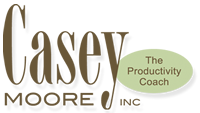
Continued from Part 1:
The Solution
Here are some strategies to make your Open Door Policy work without killing your productivity.
Apply the spirit of the law. Be open to comments, criticism and concerns. Consider the ideas you receive and take action as needed. Your warm welcome of others’ input demonstrates your openness much more than your constant availability does. “It is nothing won to admit men with an open door, yet to receive them with a shut and reserved countenance,” warned Francis Bacon.
Close the door selectively. Carve out a “sacred” hour a day (or 2-3 hours a week). Turn off the phone, disarm the email alarm, shut the door and do some work. As The Complete Idiot’s Guide to Project Management puts it, “The occasional closed door informs people to make minor decisions on their own…When the closed door is used with sensitivity and in contrast to the ODP, it can be a powerful tool for getting things done.”
Distinguish among interruptions. Tell people what kind of interruptions you welcome (e.g., urgent, important matters) and which can wait. Also, ask your direct-reports to come to you with potential solutions instead of just problems. Your interruptions will decline sharply.
Ask people to bundle their questions and comments (or send them via email) so that they contact you once about ten things instead of ten times about one thing each.
Be available on your terms. Hold regular staff or project status meetings. “Manage by walking around,” touching base when you choose. Be more accessible than even the open door implies. Still don’t think you could ever close the door? The reality is, you do it already—when you’re in a meeting or out of the office. You are not available 100% of the time. Why not add a few hours a week to your unavailability so you can do some work? It’s worth a shot! Special thanks to the “Take Control of Your Day” seminar attendees for their input.
